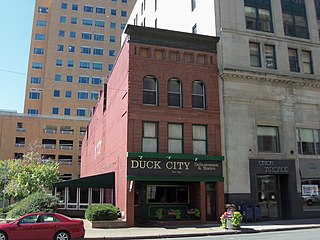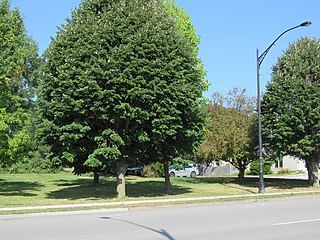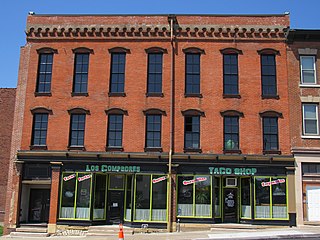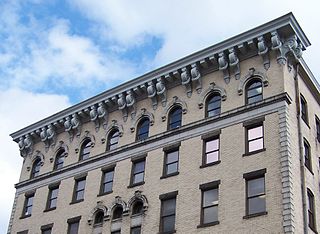
Marycrest College Historic District is located on a bluff overlooking the West End of Davenport, Iowa, United States. The district encompasses the campus of Marycrest College, which was a small, private collegiate institution. The school became Teikyo Marycrest University and finally Marycrest International University after affiliating with a private educational consortium during the 1990s. The school closed in 2002 because of financial shortcomings. The campus has been listed on the Davenport Register of Historic Properties and on the National Register of Historic Places since 2004. At the time of its nomination, the historic district consisted of 13 resources, including six contributing buildings and five non-contributing buildings. Two of the buildings were already individually listed on the National Register.

St. Mary's Catholic Church, also known as St. Mary of the Visitation Church, is a parish church of the Diocese of Davenport which is located in Iowa City, Iowa, United States. The church building and rectory were listed together on the National Register of Historic Places in 1980. They were both included as contributing properties in the Jefferson Street Historic District in 2004. The parish's first rectory, which is now a private home, is also listed on the National Register as St. Mary's Rectory. It is located a few blocks to the east of the present church location at 610 E. Jefferson St.

St. Anthony's Catholic Church is a parish church in the Diocese of Davenport. The parish complex is located in downtown Davenport, Iowa, United States, at the corner of Fourth and Main Streets. It is the first church congregation organized in the city of Davenport and the second Catholic congregation, after St. Raphael's Cathedral in Dubuque, in the state of Iowa. The parish buildings are listed on the National Register of Historic Places as St. Anthony's Roman Catholic Church Complex. The designation includes the church and the former school building, which is the parish's original church building and the oldest standing church building in Iowa. The designation also included the rectory, which was torn down in 2009. The complex was also listed on the Davenport Register of Historic Properties in 1992 as St. Anthony's Church Square. The property has been known historically as Church Square.

The German American Heritage Center, also known as the Germania-Miller/Standard Hotel, is a cultural center and museum in Davenport, Iowa, United States, that chronicles and preserves the history of German-Americans in the Midwest region. The building was listed on the National Register of Historic Places in 1983.

St. Mary's Catholic Church is a parish church of the Diocese of Davenport. The church is located at the corner of St. Mary's and Washburn Streets in the town of Riverside, Iowa, United States. The entire parish complex forms an historic district listed on the National Register of Historic Places as St. Mary's Parish Church Buildings. The designation includes the church building, rectory, the former church, and former school building. The former convent, which was included in the historical designation, is no longer in existence.

The Forrest Block is an historic building located in downtown Davenport, Iowa, United States. It was listed on the National Register of Historic Places in 1983.

The Henry Berg Building is a historic building located in downtown Davenport, Iowa, United States. It has been listed on the National Register of Historic Places since 1983. It is on the same block as Davenport Bank and Trust, Central Office Building and 202 W. Third Street. It is also next to the Ficke Block on Harrison Street. All of these structures are listed on the National Register.

The Ficke Block is a historic building located in downtown Davenport, Iowa, United States. It was listed on the National Register of Historic Places in 1983. The structure is immediately adjacent to the Henry Berg Building, which is also listed on the National Register.

The Schmidt Block is a historic building located in downtown Davenport, Iowa, United States. It was listed on the National Register of Historic Places in 1983.

The Lend-A-Hand Club was located in downtown Davenport, Iowa, United States, along the riverfront. It was listed on the National Register of Historic Places in 1983.

The Northwest Davenport Turner Society Hall is a historic building located in the old northwest side of Davenport, Iowa, United States. It has been listed on the National Register of Historic Places since 1979. The Northwest Davenport Turner Society Hall is significant for its association with Davenport's German community, which was the city's largest and most influential immigrant group. It also played an important role in the civic and cultural life of the northwest Davenport German community.

Linden Flats was located in downtown Davenport, Iowa, United States. It was individually listed on the National Register of Historic Places, and included as a contributing property in the West Third Street Historic District in 1983. The building was torn down after it was destroyed in a fire in 2005.

The House at 919 Oneida Street is a historic building located on the east side of Davenport, Iowa, United States. It has been listed on the National Register of Historic Places since 1984.

The Riepe Drug Store/G. Ott Block was located in downtown Davenport, Iowa, United States. It was listed on the National Register of Historic Places in 1983.

The Miller Building was a historic building located in the central part of Davenport, Iowa, United States. It was listed on the National Register of Historic Places in 1983.

The Eldridge Turn-Halle, also known as Tomberg's Turner Hall, was an historic building located in Eldridge, Iowa, United States. It was listed on the National Register of Historic Places in 1987. The building was destroyed in a fire in 2013 and it was delisted from the National Register in 2019.

The Warner Apartment Building was an historic building located on the east side of Davenport, Iowa, United States. Dr. Fay L. Warner, a dentist, had the structure built in 1900 and lived here himself until 1908. A relative of his, Fred Warner, lived here in later years and managed the building. The three-story brick structure was one of the most distinguished apartment blocks in Davenport. The building featured a picturesque façade that was typical of Victorian era architecture. The round arch entrances were below ogee-arched moldings. At the top was a deep corbelled cornice frieze. The five sections of the main façade were articulated by full-height octagonal bays. The building was also banded by flat and projecting string courses. The structure was on a raised lot and had a low, stone retaining wall at the sidewalk. It was listed on the National Register of Historic Places in 1983, and has subsequently been demolished.

The Schauder Hotel was a historic building located in downtown Davenport, Iowa, United States. It was built in the Italianate style facing the Mississippi River, and it was listed on the National Register of Historic Places in 1983.

This is a list of the National Register of Historic Places listings in Downtown Davenport, Iowa. This is intended to be a complete list of the properties and districts on the National Register of Historic Places in Downtown Davenport, Iowa, United States. Downtown Davenport is defined as being all of the city south of 5th Street from Marquette Street east to the intersection of River Drive and East 4th Street. The locations of National Register properties and districts may be seen in an online map.




























